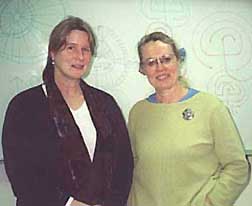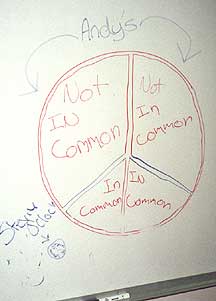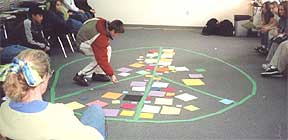THE
MANDALA PROJECT:
Mandalas in Middle School
On Wednesday, January 26, 2000, The Mandala Project was presented in a workshop format to two 7th grade classes at Anacortes Middle School. Below are my thoughts and observations about the workshops in Barbara Jackson's Math class and Sharon Clasen-Korteum's Bloc class. (Photo: Barbara Jackson and Sharon Clasen-Korteum stand in front of the board students used to illustrate mandala diagrams) Workshop Objectives
|
By asking insightful questions, Mrs.Clasen-Kortuem prodded students to think creatively and logically. Students brainstormed about what pattern would work best utilizing the mandala concept of a center and circle. Several students were selected to illustrate ideas on the board and then give persuasive speeches to convince the class that their designs would be best suited to illustrate the lesson. The class voted on the designs and the "winning" mandala was a peace sign (see photo) which divided the mandala into four sections - two for similarities, two for differences. The student with the winning design convinced the class that his idea was best because, since many of the countries were involved in wars, the peace sign would be a good symbol to use. Creating
the mandala
After the squares had been placed, the colored squares were organized into a radiating design with warm colors in the middle radiating out to the cool colors on the periphery. When the project was completed, the class encircled the mandala and posed for pictures while pointing to the center.
A student suggested burning the paper squares so that the ashes could be scattered on the earth to symbolize the circle of life–the trees that made the paper being returned to the soil. The ceremony was conducted on the lawn outside the classroom while the students sang songs. After the ashes were spread on the grass, the class returned to the classroom and wrote their impressions of the workshop. They also made a wonderful thank you card for me (Bailey Cunningham) by placing their thumbs in the ashes and printing them onto a circle of parchment paper. This now hangs in a special place in my office. Skills and Lessons learned:
|
|
After the initial mandala presentation, students were assigned to create a mandala by cutting colored paper into various geometric shapes and placing them in a symmetrical design. They were given a printed list of requirements for their geometric mandalas which included the following:
The students plunged into the project. As I walked around the room, I observed all levels of involvement in the activity including individuals focused on creating masterpieces and groups of two or three in cooperative ventures. I noticed one student who busied himself cutting triangles out of triangles until he had no more paper and then repeating the task with a new sheet of paper. I told him that I couldn't wait to see what an intricate mandala he would create out of the bazillion pieces scattered on his desk. He answered, "Yeah, right." So I sat next to him and began to arrange the triangles myself while engaging him in conversation. "What do you like to do?" I asked. "Nothing that makes me think." he replied. "So what does that look like?" "Watching TV." "What else?" "Playing Nintendo." So, while I arranged his triangles in a coherent design, I continued conversing with him, occasionally asking him to give me certain sizes or types of triangles in certain colors. He honored my requests, making sure not to appear the least bit interested in what I was doing. After I had created a crude representation of a mandala with various colored triangles, I went on to the next station where three girls were on the floor, excitedly creating and gluing their mandala together. At the end of the class, all the mandalas were gathered into a box. After the students left, the teacher and I pulled them all out to take a look. I was surprised and pleased to see a completed mandala made by the boy who seemed uninterested in the project. Siezing
opportunities Mrs. Jackson, by being aware of her students and their different needs and different learning styles, realized that she could employ another method to teach the geometry lesson. Creation of the paper cranes involved folding paper into many triangles and incorporated the lesson into an engaging activity that students both benefited from and enjoyed. I relay these stories as they illustrate how using alternative teaching techniques can be beneficial for students, especially for those with different learning styles. Mandala workshops use a variety of teaching techniques that address different learning styles and can get a student who has "checked out" involved in the learning process again. The following week, completed mandalas were handed out randomly to the students along with copies of the requirement list. Students then "graded" each other's work based on completion of the requirements. After the evaluations, the mandalas were mounted on the board and hung as mobiles. As the students proudly posed in front of their work for photos, I was impressed by the creativity each one of them expressed while learning the same lesson plan (that could have been presented straight from the textbook). The act of creating art, combined with the lesson material, probably imprinted the concepts more deeply on their minds–not only because it was fun, but because they were more actively involved in the process–physically, mentally, and emotionally. |
 Using
the Mandala
Using
the Mandala  Mrs.
Clasen-Kortuem chose to use the mandala workshop to reinforce history
lessons. Students has already used "Venn diagrams" to illustrate
similarities and differences between countries on which they were
writing reports. The students were asked to come up with a mandala
design in which they could collectively display the "compare
and contrast" information they had gathered the day before.
Mrs.
Clasen-Kortuem chose to use the mandala workshop to reinforce history
lessons. Students has already used "Venn diagrams" to illustrate
similarities and differences between countries on which they were
writing reports. The students were asked to come up with a mandala
design in which they could collectively display the "compare
and contrast" information they had gathered the day before.  Each
student selected four pieces of paper–two for similarities, two
for differences. One-by-one students stood in front of the class to
explain what each paper square represented and then placed the squares
in the appropriate section of the peace mandala.
Each
student selected four pieces of paper–two for similarities, two
for differences. One-by-one students stood in front of the class to
explain what each paper square represented and then placed the squares
in the appropriate section of the peace mandala.  Seeking
closure
Seeking
closure Mrs.
Jackson's class was beginning studies in geometry. Since the Mandala
Project workshops can be easily tailored to focus on a variety of
subjects, Mrs. Jackson chose to have the workshop include the following
Washington Assessment of Student Learning (WASL) specifications in
the lesson plan:
Mrs.
Jackson's class was beginning studies in geometry. Since the Mandala
Project workshops can be easily tailored to focus on a variety of
subjects, Mrs. Jackson chose to have the workshop include the following
Washington Assessment of Student Learning (WASL) specifications in
the lesson plan: